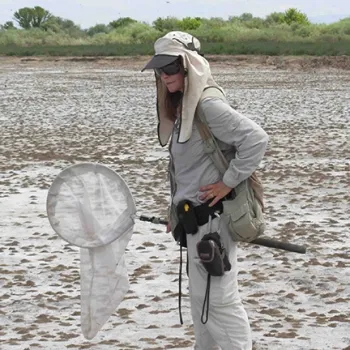Groundbreaking Case of Exploitation, Deception: What UC Davis-UC Riverside Scientists Learned About Parasitic Blister Beetles and Digger Bees

The scenario begins when aggregations of beetle larvae of Meloe franciscanus emit chemical signals that mimic the sex pheromones of female bees luring male digger bees to make contact. The Meloe larvae then attach to males bees on contact, Habropoda pallida, from California's Mojave Desert and H. miserabilis from the coastal dunes of Oregon.
During subsequent copulations, the larvae transfer from males to females, hitching a ride on female bees to their nests, where the larvae feed on the provisions and the bee egg, and emerge as adults the following winter, said Saul-Gershenz. The research paper, “Deceptive Signals and Behaviors of a Cleptoparasitic Beetle Show Local Adaptation to Different Host bee Species,” appears in the current edition of Proceedings of the National Academy of Sciences (PNAS).
In solving the puzzle, the scientists tested whether geographically isolated populations of M. franciscanus larvae--from Oregon's coast and California's Mojave Desert--use local adaptations to exploit their respective hosts, H. miserabilis and H. pallida.
“Interestingly, male H. miserabilis were attracted to conspecific females and to aggregations of local Meloe larvae, but not to male bees,” Saul-Gershenz said. “Importantly, male bees of both bee species were more attracted to local parasite larvae than larvae from the distant locale because the larvae tailored their pheromone-mimicking blends to the pheromones of their local hosts. Additionally, the larval aggregation adapted their perching height at each location to the patrolling height of local male bees.”

In their abstract, the scientists wrote: "Chemosensory signals play a key role in species recognition and mate location in both invertebrate and vertebrate species. Closely related species often produce similar but distinct signals by varying the ratios or components in pheromone blends to avoid interference in their communication channels and minimize cross- attraction among congeners. However, exploitation of reproductive signals by predators and parasites also may provide strong selective pressure on signal phenotypes. For example, bolas spiders mimic the pheromones of several moth species to attract their prey, and parasitic blister beetle larvae, known as triungulins, cooperatively produce an olfactory signal that mimics the sex pheromone of their female host bees to attract male bees, as the first step in being transported by their hosts to their nests.”
“In both cases, there is strong selection pressure on the host to discriminate real mates from aggressive mimics and, conversely, on the predator, parasite, or parasitoid to track and locally adapt to the evolving signals of its hosts,” the co-authors pointed out. “Here we show local adaptation of a beetle, Meloe franciscanus (Coleoptera: Meloidae), to the pheromone chemistry and mate location behavior of its hosts, two species of solitary bees in the genus Habropoda. We report that M. franciscanus' deceptive signal is locally host-adapted in its chemical composition and ratio of components, with host bees from each allopatric population preferring the deceptive signals of their sympatric parasite population. Furthermore, in different locales, the triungulin aggregations have adapted their perching height to the height at which local male bees typically patrol for females. "
Saul-Gershenz said that the study “provides strong evidence for two different but complementary types of local adaptation in geographically isolated populations of a parasitic insect.” Specifically, the beetles locally adapt their deceptive chemical signals to the differing pheromone blends of their local host species and “the local nest parasites are significantly more attractive to male bees than nonlocal parasites, using transplant experiments.” The scientists identified the attractant blends for the two host species and the compounds that the beetle larvae produce to attract their hosts. They also showed that the two parasite populations have evolved divergent host-matching behaviors.
“The blister beetle Meloe franciscanus has turned out to be an engaging research subject, commented Saul-Gershenz, who received her doctorate in entomology from UC Davis, studying with Neal Williams and Steve Nadler, professor and chair of the UC Davis Department of Entomology and Nematology. She is now an associate director of research, Wild Energy Initiative, John Muir Institute of the Environment, UC Davis. “The larvae cooperate with their siblings for a brief period; they mimic the pheromone of their hosts; they are locally adapted to different hosts both chemically and behaviorally; and their emergence times are plastic across their geographic range. It has been fantastic to unravel this species' puzzle.”
She credited the counsel of the “true native bee icons in my field"--Robbin Thorp, UC Davis distinguished emeritus professor of entomology; research entomologist Jim Cane, Agricultural Research Service of U.S. Department of Agriculture; research entomologist Tom Zavortink, Bohart Museum of Entomology and former professor and chair of the University of Francisco Department of Biology; blister beetle (Meloidae) expert John Pinto, UC Riverside emeritus professor; and emeritus entomologist Rick Westcott, Oregon Department of Agriculture.
Future plans? Saul-Gershenz and Millar will continue exploring chemical communication signals as reproductive isolating mechanisms and the effect of eavesdropping parasites, parasitoids and predators on these signals. “I also plan to continue collaborating with Dr. Rebecca Hernandez and her lab members (UC Davis Department of Land, Air and Water Resources, and the Wild Energy Initiative of the John Muir Institute of the Environment) on the intersection of utility-scale solar energy development and our wildlife resources,” Saul-Gershenz said. In addition, she will continue her research on the impact on native bee diversity and pollination services from utility-scale solar development in the western deserts.
The research drew funding from Sean and Anne Duffey and Hugh and Geraldine Dingle Research Fellowship, the Community Foundation's Desert Legacy Fund, California Desert Research, Disney Wildlife Conservation Fund, and UC Davis Department of Entomology and Nematology fellowships.
